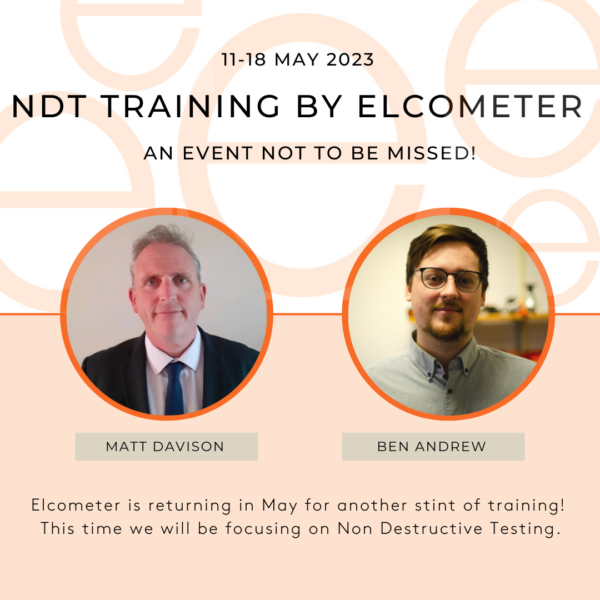
Elcometer is returning in May for another stint of training!
This time we will be focusing on Non Destructive Testing.
Matt Davison and Ben Andrew from Elcometer UK will be in South Africa to conduct a series of training sessions.
Matt Davison began working as a Technical Apprentice at the United Kingdom Atomic Energy Authority in 1986. He then transferred into NDT in 2003 and has since worked in such companies as Staveley Instruments, Olympus NDT and Sonatest. He is now responsible for the global NDT business of Elcometer with has now grown 32% in last 2 years.
Ben Andrew is Elcometer NDT’s primary Technical Support Engineer and acts as key contact for any issues related to Ultrasonic Testing equipment from Elcometer’s global sales network. Ben joined Elcometer in 2021 and has a strong educational background in Physics, Maths and Software Design. Within UT as a discipline, Ben recently completed his PCN Level 2 UT Weld Inspection examinations from Lavender International with a Distinction grade. His specialisms are in bolt tension measurement and finding novel applications for A-Scan equipment. Outside of direct technical support, Ben also writes articles and guides for publication by Elcometer, and has had articles published by Surface World and ASNT Pulse.
Details are as follows:
Johannesburg: Thursday 11 May: Half Day Training – morning (Country Club CCJ)
Cape Town: Tuesday 16 May: Half Day Training – afternoon (Kelvin Grove Club)
Port Elizabeth: Thursday 18 May: Half Day Training – afternoon
_____________________________________
Details of the course content as follows:
Section 1: Ultrasonic Thickness Primer & Numerical Thickness Gauges
We’ll introduce numerical thickness gauges, get the delegates thinking about the basics in terms of attenuation (how hard it is to scan a material), time (how long it takes for the pulse to go through the material) and how they might go about choosing the best transducer for their application.
Theoretical Component: The Basics
Introduction to the basic concepts present within Ultrasonic Testing.
– A few slides explaining exactly what ultrasound is and how it travels
– Cover the basic physics of speed, distance & time that form the basis of measurement.
– Delay lines, dead zones, single vs. dual element, etc. etc.
Practical Component: Numerical Thickness Gauges
Get the delegates up and around a table to test out the MTG & PTG on our test pieces.
– Basic operations
– Calibration
– Troubleshooting
– Limitations
_____________________________________
Section 2: Intermediate UT – A-Scans and their Use
The second section will focus almost entirely on how A-Scans work, with analogies to camera
controls that most should be familiar with. It’ll cover the basics of corrosion analysis,
overviews of the kinds of measurement modes you gain access to with gates and traces,
etc.
Theoretical Component: A-Scan Control Theory, Measurement Modes
The next step up from Numerical gauges are A-Scan gauges, that have an oscilloscope-like display that can allow you to get even more information from the system under test.
– Control basics; gain, range, delay, rectification, gates, etc.
– Measurement modes; how they work and which ones to use.
– Basic echodynamics; what does the trace tell us about the test item?
Practical Component: A-Scan Thickness Gauges
Get the delegates back up to do what they did before, but this time with an A-Scan gauge.
– Basic operations
– Calibration
– Troubleshooting
– Flaw Signals
– Solving Numerical TG Limitations
________________________________________
Section 3: Flaw Detection & Weld Inspection
Section three covers all things Flaw Detection. There is no practical component for this, because it’s very
complicated and much easier to demonstrate than to teach.
Theoretical Component: Flaw Detection, Weld Inspection, Castings & Forgings
– Sizing Tools: DAC Curves, Trigonometry, AWS D1.1, AVG/DGS, dB drop
– Weld Inspection: Lamination scans, root scans, fusion face scans
– Castings & Forgings: Cast iron is difficult, single element transducers
________________________________________
Section 4: Bolt Tension Monitoring
Our final section is all about our special niche; the Bolt Gauge. This is an increasingly popular product range for us, and we’re the only ones who currently provide modern solutions to this market sector.
Theoretical Component: What is bolt tension and how do you measure it?
Go through everything you need to consider before you decide to implement the bolt gauge into your workflow.
– Zeroing & Velocity Calibration
– Sonic Stress Factor
– Load Factor
– Temperature Factor
– Caveats and Addenda
If you are interested in attending, please advise us as soon as possible by filling in the following form:
BAMR Elcometer Training May 2023 – Google Form
All delegates will receive an Elcometer Certificate
CPD Points have been applied for
All delegates will be entitled to the following:
Extra 5% Discount off the purchase of any instruments that will be covered in the course including:
Elcometer MTG2 Ultrasonic Material Thickness Gauge
Elcometer MTG4 Ultrasonic Material Thickness Gauge
Elcometer MTG6 Ultrasonic Material Thickness Gauge
Elcometer MTG8 Ultrasonic Material Thickness Gauge
Elcometer CG70ABDL Ultrasonic Material Thickness Gauge
Elcometer NDT CG100ABDL+ Corrosion Ultrasonic Thickness Gauge
Elcometer NDT FD700+ Ultrasonic Flaw Detectors Detection Gauges
Elcometer NDT BG80TDL Bolt Tension Monitors
Any purchase over R10,000 in the last 6 months will entitle a company to one free delegate
Please RSVP as soon as possible
Enquiries & RSVP to:
Graham Duk
[email protected]

